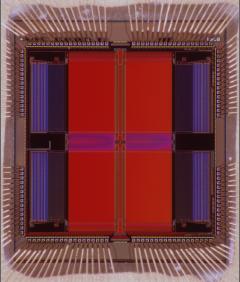Kerneltron: Implantable Pattern Recognition Processor
 Detection of
complex objects in streaming video requires a significant amount of
computation by the classifier operating in real time. This computation is
dominated by the evaluation of a kernel between an input vector and a set of
stored templates. For a large class of kernels the computation involves a
matrix-vector multiplication (MVM) in large dimensions. For complex pattern
recognition tasks this requires millions of matrix multiply-accumulates for
each classification per frame of the streaming video. To handle this task, a
pattern recognition processor, the Kerneltron, has been prototyped in a 0.5
um CMOS technology. This massively parallel processor combines a fine grain
analog computational array with oversampling quantizers to efficiently
compute the MVM. The goal of my work has been twofold. First, a new
generation Kerneltron-family processor has been designed. Second, I have
further enhanced the Kerneltron technology through cell-level and chip-level
circuit innovations. Detection of
complex objects in streaming video requires a significant amount of
computation by the classifier operating in real time. This computation is
dominated by the evaluation of a kernel between an input vector and a set of
stored templates. For a large class of kernels the computation involves a
matrix-vector multiplication (MVM) in large dimensions. For complex pattern
recognition tasks this requires millions of matrix multiply-accumulates for
each classification per frame of the streaming video. To handle this task, a
pattern recognition processor, the Kerneltron, has been prototyped in a 0.5
um CMOS technology. This massively parallel processor combines a fine grain
analog computational array with oversampling quantizers to efficiently
compute the MVM. The goal of my work has been twofold. First, a new
generation Kerneltron-family processor has been designed. Second, I have
further enhanced the Kerneltron technology through cell-level and chip-level
circuit innovations.
The first part of the project involved prototyping a large-scale version of
the Kerneltron processor with an order of magnitude improvement in the
computational efficiency (throughput per unit power) over the previous
prototype. On a system level, a multiprocessor PCI-based PC card containing 8
new-generation Kerneltron processors has been developed and prototyped. The
multi-chip system will be demonstrated in real time object detection in
streaming video.
The second part of the project has been to design, prototype, and
experimentally characterize a new architecture with circuit innovations aimed
at further improvement in computational efficiency. The objective was to
design a denser cell operating with a smaller supply voltage. This processor
will be used to demonstrate the enhanced potential of the computing
technology.
The finished project is a Kerneltron based system for object detection in
streaming video. The high computational efficiency of the Kerneltron
technology is ideal for portable, low-power applications.
|